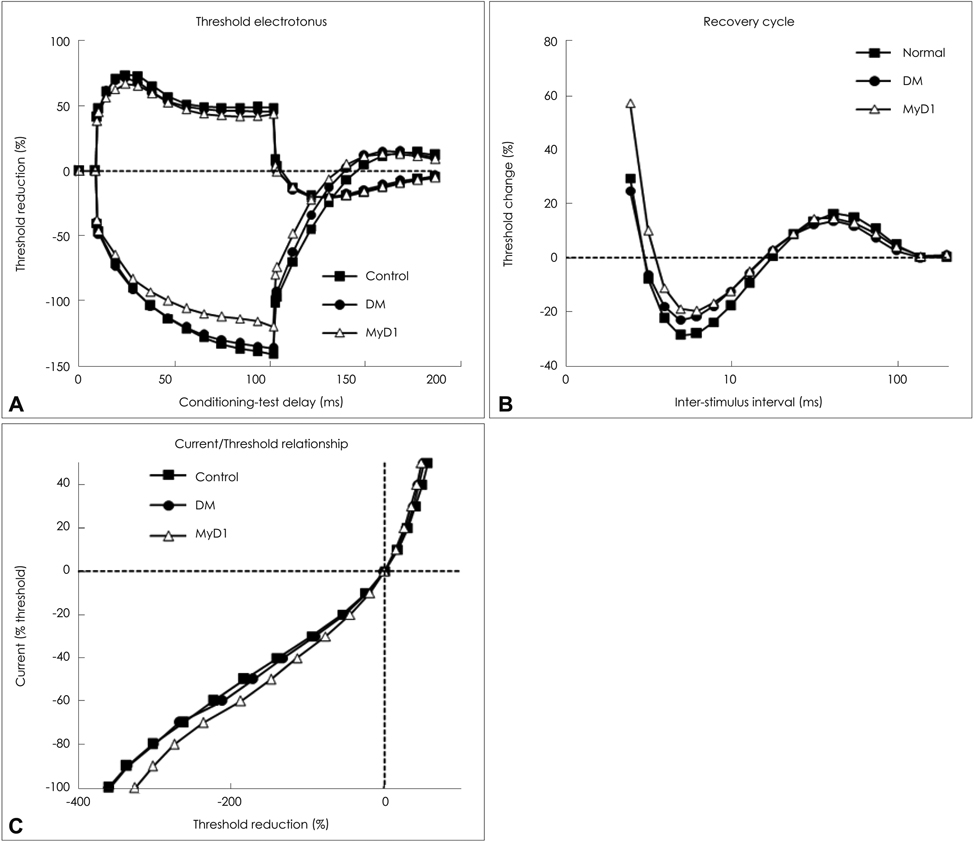J Clin Neurol.
2011 Jun;7(2):90-95. 10.3988/jcn.2011.7.2.90.
Peripheral Nerve Axon Involvement in Myotonic Dystrophy Type 1, Measured Using the Automated Nerve Excitability Test
- Affiliations
-
- 1Department of Neurology, Inje University College of Medicine, Busan, Korea. neurobae@yahoo.co.kr
- KMID: 2178972
- DOI: http://doi.org/10.3988/jcn.2011.7.2.90
Abstract
- BACKGROUND AND PURPOSE
Primary involvement of the peripheral nerves in myotonic dystrophy type I (MyD1) is controversial. We investigated whether the involvement of peripheral nerves is a primary event of MyD1 or secondary to another complication such as diabetes mellitus (DM).
METHODS
The subjects comprised 12 patients with MyD1, 12 with DM and no peripheral nerve involvement, and 25 healthy volunteers. We measured multiple excitability indices in the median motor axons. The strength-duration time constant was calculated from the duration-charge curve, the threshold electrotonus and current-threshold relationships were calculated from the sequential subthreshold current, and the recovery cycle was derived from double suprathreshold stimulation.
RESULTS
The depolarizing and hyperpolarizing threshold electrotonus were significantly reduced and exhibited increased refractoriness in the MyD1 group compared with the DM and control groups. The SDTC, superexcitability, and subexcitability were not significantly altered in the MyD1 group.
CONCLUSIONS
The MyD1 group exhibited a depolarized axonal membrane potential. The significant differences in peripheral nerve excitability between the MyD1 group and the DM and normal control groups suggest that peripheral neuropathy is a primary event in MyD1 rather than a secondary complication of DM.
Keyword
MeSH Terms
Figure
Reference
-
1. Harley HG, Rundle SA, Reardon W, Myring J, Crow S, Brook JD, et al. Unstable DNA sequence in myotonic dystrophy. Lancet. 1992. 339:1125–1128.
Article2. Meola G, Moxley RT III. Schapira AHV, Griggs RC, editors. Myotonic disorder: Myotonic dystrophy and proximal myotonic myopathy. Muscle diseases. 1999. Woburn: Butterworth-Heinemann;115–134.3. Caccia MR, Negri S, Parvis VP. Myotonic dystrophy with neural involvement. J Neurol Sci. 1972. 16:253–269.
Article4. McComas AJ, Sica RE, Toyonaga K. Incidence, severity, and time-course of motoneurone dysfunction in myotonic dystrophy: their significance for an understanding of anticipation. J Neurol Neurosurg Psychiatry. 1978. 41:882–893.
Article5. Jamal GA, Weir AI, Hansen S, Ballantyne JP. Myotonic dystrophy. A reassessment by conventional and more recently introduced neurophysiological techniques. Brain. 1986. 109:1279–1296.6. Olson ND, Jou MF, Quast JE, Nuttall FQ. Peripheral neuropathy in myotonic dystrophy. Relation to glucose intolerance. Arch Neurol. 1978. 35:741–745.7. Paramesh K, Smith BH, Kalyanaraman K. Early onset myotonic dystrophy in association with polyneuropathy. J Neurol Neurosurg Psychiatry. 1975. 38:1136–1139.
Article8. Perseghin G, Caumo A, Arcelloni C, Benedini S, Lanzi R, Pagliato E, et al. Contribution of abnormal insulin secretion and insulin resistance to the pathogenesis of type 2 diabetes in myotonic dystrophy. Diabetes Care. 2003. 26:2112–2118.
Article9. Logullo F, Censori B, Danni M, Del Pesce M, Di Bella P, Provinciali L. Peripheral neuropathy in myotonic dystrophy: electrophysiological and clinical features. Electromyogr Clin Neurophysiol. 1992. 32:515–520.10. Roohi F, List T, Lovelace RE. Slow motor nerve conduction in myotonic dystrophy. Electromyogr Clin Neurophysiol. 1981. 21:97–105.11. Bril V. NIS-LL: the primary measurement scale for clinical trial endpoints in diabetic peripheral neuropathy. Eur Neurol. 1999. 41:Suppl 1. 8–13.
Article12. Feldman EL, Stevens MJ, Thomas PK, Brown MB, Canal N, Greene DA. A practical two-step quantitative clinical and electrophysiological assessment for the diagnosis and staging of diabetic neuropathy. Diabetes Care. 1994. 17:1281–1289.
Article13. Mogyoros I, Kiernan MC, Burke D. Strength-duration properties of human peripheral nerve. Brain. 1996. 119:439–447.
Article14. Z'Graggen WJ, Lin CS, Howard RS, Beale RJ, Bostock H. Nerve excitability changes in critical illness polyneuropathy. Brain. 2006. 129:2461–2470.15. Dyck PJ. Arnold Gries F, Cameron NE, Low PA, Ziegler D, editors. Severity and staging of diabetic polyneuropathy. Textbook of diabetic neuropathy. 2003. NewYork: Georg Thieme Verlag;170–175.16. Krishnan AV, Kiernan MC. Axonal function and activity-dependent excitability changes in myotonic dystrophy. Muscle Nerve. 2006. 33:627–636.
Article17. Cros D, Harnden P, Pouget J, Pellissier JF, Gastaut JL, Serratrice G. Peripheral neuropathy in myotonic dystrophy: a nerve biopsy study. Ann Neurol. 1988. 23:470–476.
Article18. De Freitas GR, De Freitas MR, Nascimento OJ. [Sural nerve biopsy in myotonic muscular dystrophy]. Arq Neuropsiquiatr. 1996. 54:19–24.19. Mondelli M, Rossi A, Malandrini A, Della Porta P, Guzaai GC. Axonal motor and sensory neuropathy in myotonic dystrophy. Acta Neurol Scand. 1993. 88:141–148.
Article20. Pfeilsticker BH, Bertuzzo CS, Nucci A. Electrophysiological evaluation in myotonic dystrophy: correlation with CTG length expansion. Arq Neuropsiquiatr. 2001. 59:186–191.
Article21. Kuwabara S, Misawa S. Axonal ionic pathophysiology in human peripheral neuropathy and motor neuron disease. Curr Neurovasc Res. 2004. 1:373–379.
Article22. Misawa S, Kuwabara S, Kanai K, Tamura N, Hiraga A, Nakata M, et al. Axonal potassium conductance and glycemic control in human diabetic nerves. Clin Neurophysiol. 2005. 116:1181–1187.
Article23. Misawa S, Kuwabara S, Ogawara K, Kitano Y, Hattori T. Strength-duration properties and glycemic control in human diabetic motor nerves. Clin Neurophysiol. 2005. 116:254–258.
Article24. Misawa S, Kuwabara S, Ogawara K, Kitano Y, Yagui K, Hattori T. Hyperglycemia alters refractory periods in human diabetic neuropathy. Clin Neurophysiol. 2004. 115:2525–2529.
Article
- Full Text Links
- Actions
-
Cited
- CITED
-
- Close
- Share
- Similar articles
-
- Radiofrequency Catheter Ablation of Persistent Atrial Fibrillation with Myotonic Dystrophy and Achalasia-like Esophageal Dilatation
- Axon Diameter in Normal Human Optic Nerve
- Normal data on axonal excitability in Koreans
- Myotonic Dystrophy Type 1 With Brain MRI Lesions Involving White Matters in Anterior Temporal Pole and Insula
- Accidentally Diagnosed Myotonic Dystrophy after Cholecystectomy


